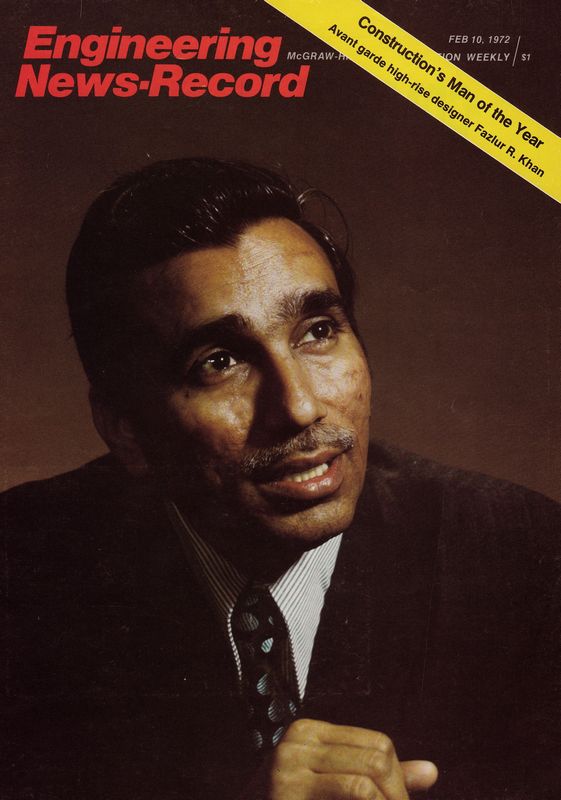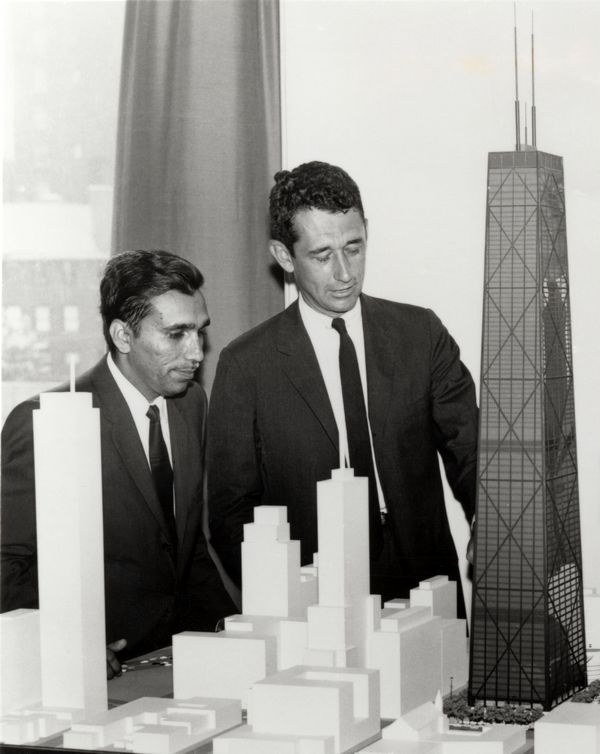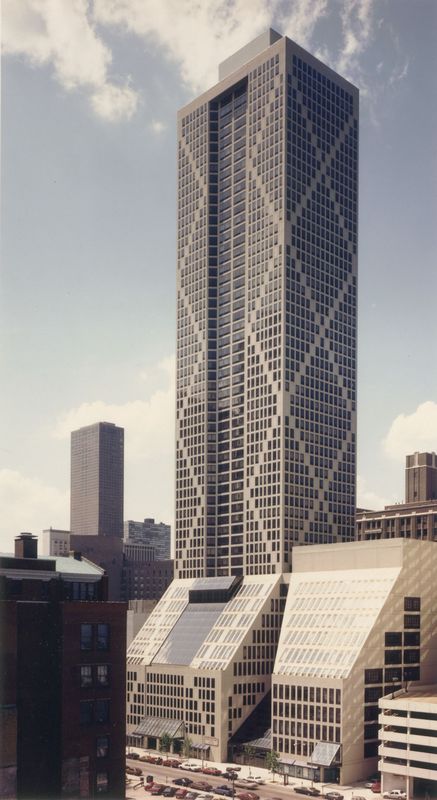Lehigh University
Office or Center Name Here
Dr. Fazlur R. Khan (1929–1982): Engineering Pioneer of Modern Architecture
by Yasmin S. Khan
Fazlur R. Khan initiated structural systems that are fundamental to tall building design today. In a career marked by innovation in structural engineering and collaboration between engineering and architecture, Khan introduced design methods and concepts that set new standards for efficient use of material and suggested new possibilities for building architecture.
Formative Years
Fazlur Khan was born April 3, 1929 in Dhaka, Bangladesh (at the time, Dacca, East Bengal, in British India). With the encouragement of his father—a mathematics instructor, the author of mathematics textbooks, and, later, an Assistant Director of Public Instruction for Bengal—Khan discovered the pleasure of learning during his teen years. He became comfortable analyzing and discussing problems and considering them from various perspectives. At the same time, he learned to appreciate life; “and life,” Khan emphasized in 1971, on the occasion of his selection as Engineering News-Record’s Construction’s Man of the Year, “is art, drama, music, and most importantly, people.” (Note1)

Khan was cited five times by Engineering News-Record as among those who served the best interests of the construction industry, and in 1972 he was honored with ENR's Man of the Year award.
Khan selected civil engineering for his undergraduate studies, excelled in his coursework, and received two scholarships for advanced studies in the United States, a Fulbright Scholarship and a Pakistan government scholarship. The Fulbright program placed him at the University of Illinois at Urbana-Champaign, a stimulating environment that suited him perfectly. The professors, themselves highly respected in their fields, were at once demanding and supportive. His coursework instilled the value of critical thinking and “broadening ones approach to new problems,” and, equally influential to his career, demonstrated the beauty of concepts that are, in his words, “elegantly simple.” (Note2)
Structural Systems for High-Rise Buildings
When Fazlur Khan joined the Chicago office of Skidmore, Owings & Merrill (SOM) on a permanent basis in 1960, the options available to designers of multistory buildings were surprisingly limited. Beam–column “skeleton” frame construction, in which columns were spaced at 10 to 16 feet throughout the building, was the norm. Alternatively, engineers could design shear walls in concrete construction, or shear trusses in steel construction, to resist lateral loads. The frame, shear wall, and shear truss systems were appropriate for buildings up to 20 or 30 stories, but became inefficient and uneconomical in taller structures. It was generally accepted that unit area cost increased disproportionately to building height.
_1_800X600.jpg)
Chestnut-DeWitt Apartments in Chicago, completed in 1964, initiated the three-dimensional tubular concept for high-rise design (Hedrich Blessing, courtesy of Skidmore, Owings & Merrill LLP)
Khan’s initial work at SOM involved prestressed concrete—the topic of his doctoral thesis—but when opportunities arose to design a 37-story reinforced concrete office tower and a 43-story apartment building, he gladly seized them. The 37-story Brunswick Building in Chicago was expected to obtain its lateral stiffness from shear walls at its core. As design progressed, however, Khan recognized that the selected column spacing resulted in stiff beam–column frames. Although the shear wall and frame systems were not commonly combined, he decided to allocate a portion of the lateral load to the frames. More important, he drew on his experience with this design to suggest the use of an interacting system for other buildings. Dedicating long hours to preparing practical design aids, he instituted a life-long practice of sharing his ideas for design, along with recommendations for analysis of the new structural forms, by way of professional publications and lectures.
The 43-story Chestnut-DeWitt Apartments in Chicago was also expected to derive its lateral stiffness from shear wall construction, although locating walls in the floor plan proved problematic. Khan’s discussions with the design architect, Bruce J. Graham, prompted him to consider the building structure in full and propose a completely new type of structural system. Graham, a partner and chief design architect in SOM’s Chicago office, was receptive to Khan’s idea for creating a perimeter shell of closely spaced columns and stiff spandrel beams to implement cantilever action of a three-dimensional structural form. The decision was made to proceed with this system, and in 1964 Chestnut-DeWitt Apartments became the first high-rise constructed as a “framed tube.”
_1_800X600.jpg)
Khan's bundled tube concept, initiated in the Sears Tower design (now the Willis Tower), offered an efficient structural system with unprecedented flexibility for architectural design (Timothy Hursley, courtesy of Skidmore, Owings & Merrill LLP)
Khan was quite excited about the new system’s dramatic advance in structural efficiency for high-rise design. Nevertheless, he acknowledged that inefficiency due to shear-lag limited its applicability. Convinced that the basic framed tube was not an optimal solution for buildings over 50 stories, at most 70 stories, he commenced his search for other systems.
During the next five years Khan developed an astonishing number of new structural systems that provided strength and stiffness with minimum premium for height. For the 100-story John Hancock Center in Chicago, he designed the first “trussed tube”; for One Shell Plaza in Houston, he developed the “tube-in-tube”; for One Shell Square in New Orleans, he combined reinforced concrete and structural steel in a “composite tube”; for the Sears Tower (now the Willis Tower), the world’s tallest building from its completion in 1974 until the completion of the Petronas Tower spires in 1996, he initiated the “bundled tube.”
By designing structures based on structural principles with broad application he changed the way engineers and architects thought about high-rise design. The composite tube and the bundled tube, in particular, represented significant breakthroughs, paving the way to a multitude of new possibilities for structural design. Following the introduction of the composite structure (One Shell Square was completed in 1972), engineers were no longer forced to choose between concrete and steel when designing a tall building, but could mix these structural materials, instead.
Reflecting the enthusiasm created by the bundled tube, Architectural Record referred to it as “perhaps the most intriguing concept to evolve in the ultra-high skyscraper.” (Note3) This concept offered unprecedented flexibility in creating architectural space and new possibilities for architectural expression. At the same time, the modular, or bundled, tube provided remarkable structural stiffness: the structural steel weight of the 1,450-foot-tall Sears Tower is a low 33 lb. per sq. ft. of gross floor area—for comparison, that of the 1,250-foot-tall, skeleton frame, Empire State Building is over 42.
_1_800X600.jpg)
John Hancock Center in Chicago. Khan was concerned that apartment residents in the upper floors (offices are located in the lower portion of the 100-story tower) might experience discomfort due to building motion (Hedrich Blessing, courtesy of Skidmore, Owings & Merrill LLP)
Motion Tests for the John Hancock Center
Khan was involved in testing throughout his career, whether it was pulling a model with a string (with graduate students he advised at the Illinois Institute of Technology), testing a concrete beam in a university laboratory (for the record-setting deep beams of the Brunswick Building), or assessing the properties of a progressive structural fabric for a tensile structure (to create the tent-like roof structures of the Hajj Terminal). He was able to judge when to undertake sophisticated research, and when to devise simple tests.
A telling illustration of Khan’s insightful approach to design and testing dates to 1965, when he was working on the John Hancock Center. The engineers had calculated the anticipated sway of the 100-story tower based on their design of a trussed tube structure. But guidelines were not yet available for predicting whether this motion would cause discomfort to the building residents. Khan was pondering how to evaluate perception of building motion when he visited Chicago’s Museum of Science and Industry with his family one Sunday. Standing on the large rotating platform of a washing machine exhibit, he realized that the platform could serve the purpose. He conceived a means of testing subjects, who stood, sat, or lay on the platform as he varied its acceleration, and assessed their responses. Based on the results, together with those from another simple test, he was able to predict that most occupants would not experience discomfort in strong wind.

Fazlur Khan and Bruce Graham with a model of the John Hancock Center (K & S PhotoGraphics, courtesy of Skidmore, Owings & Merrill LLP)
Teaching and Collaboration
In 1961, an architect at SOM, Myron Goldsmith, introduced Khan to the Illinois Institute of Technology (IIT). Goldsmith taught and advised graduate architecture students at IIT, and he asked Khan to join him. Khan became an adjunct professor, teaching structures to architecture students and serving as co-advisor, with Goldsmith, on master’s thesis projects. He enjoyed teaching and had a knack for making design topics relevant to students’ larger interests.
Advising students at IIT also allowed Khan to explore concepts for structural systems. Making the transition from theoretical investigation to practical application, Khan then assumed the responsibility for developing these concepts for construction projects. He presented them to colleagues at SOM when a new system offered an efficient solution for a building. Bruce Graham soon began to discuss alternatives with Khan before establishing an architectural concept for a project. Graham sensed that Khan had an intuitive understanding of structural behavior—founded on his strong educational training—and appreciated the rational, elegantly simple, structures that he proposed. For his part, Khan treasured the opportunity this early involvement and communication afforded him. Graham’s openness to rational architecture challenged him to develop systems with visual clarity and enabled him to participate in the shaping of building architecture.

Onterie Center in Chicago. Although many of Khan's ideas quickly found application, some were only implemented years later; the concrete trussed tube is one example. Khan studied the system with graduate architecture students in the late 1960s, shortly after developing the trussed tube in steel for the John Hancock Center, but did not develop the system in concrete until the early 1980s (Greg Murphey, courtesy of Skidmore, Owings & Merrill LLP)
Fazlur Khan and Bruce Graham’s work exemplified collaboration between engineer and architect. Their professional regard for each other, moreover, was strengthened by personal respect. Recalling Graham’s admiration of Khan, his daughter recently said of Graham: he cherished Khan, “not just for his mind and creativity, but for his heart and humanity.”(Note4)
Not all of their designs were tall buildings; for the Central Facilities Building at Baxter International’s suburban campus near Chicago, for example, they developed a cable stayed roof system. Khan was pleased with the result of the design effort, which created a large dining hall, unencumbered by columns and enclosed by glazed perimeter walls. The spirit of the space, he wrote, is that of “celebration and relaxation.” (Note5)
He was similarly pleased with his design (with architect Gordon Bunshaft of SOM’s New York office) for the Hajj Terminal of the international airport in Jeddah, Saudi Arabia, which provides an enormous waiting area sheltered from the sun. The tent-like tensile structures advanced the theory and technology of fabric as a structural material and led the way to its use for other types of terminals and large spaces.
Awards and Chair
One week before his 53rd birthday Khan suffered a fatal heart attack. He is buried in Graceland Cemetery in Chicago.
His contributions to his profession were widely acknowledged during his lifetime. He was honored with numerous awards from both engineering and architecture organizations, and in 1973 he was elected to the National Academy of Engineering. He received Honorary Doctorates from Northwestern University, Lehigh University, and the Swiss Federal Institute of Technology (ETH) Zurich.
Since Khan’s passing, several awards have been established in his honor, along with a chair at Lehigh University. Promoting educational activities and research, the Fazlur Rahman Khan Endowed Chair of Structural Engineering and Architecture honors Khan’s legacy of engineering advancement and architectural sensibility.
_1_800X600.jpg)
Looking up at the tensile structure of the Hajj Terminal at Jeddah's King Abdul Aziz International Airport (Jay Langlois/Owens-Corning Fiberglas, courtesy of Skidmore, Owings & Merrill LLP)
Yasmin Sabina Khan
The author, Khan’s daughter, has written a detailed account of Fazlur Khan’s career in Engineering Architecture: The Vision of Fazlur R. Khan (W.W. Norton, 2004).
Web sites dedicated to Dr. Khan and the Khan Endowed Chair at Lehigh, respectively: http://drfazlurrkhan.com and http://www.lehigh.edu/~infrk.
Notes
- Richard M. Kielar, “Construction’s Man of the Year: Fazlur R. Khan,” Engineering News-Record (February 10, 1972): 23. (Go Back)
- Fazlur. R. Khan, “Creative Teaching and Its Influence on Innovative Concrete Structures” (paper presented at the Annual Convention of the American Concrete Institute, Washington, D.C., November 1979). (Go Back)
- Robert. E. Fischer, “Optimizing the Structure of the Skyscraper,” Architectural Record (October 1972): 103. (Go Back)
- Mara Graham Dworsky, April 29, 2011, Comment to blog post, at http://statueoflibertybook.com/2011/03/27/anniversary-day-march-27/#comments. (Go Back)
- Fazlur R. Khan,” Structural Theories and Their Architectural Expression: A Review of Possibilities,” Chicago Architectural Journal 1 (1981), 40. (Go Back)
The Fazlur R. Khan Distinguished Lecture Series has been initiated and organized by Dan M. Frangopol, the first holder of Lehigh's Fazlur Rahman Khan Endowed Chair of Structural Engineering and Architecture.
_1_800X600.jpg)
Fazlur Khan, c. 1973 (courtesy Skidmore, Owings & Merrill LLP)